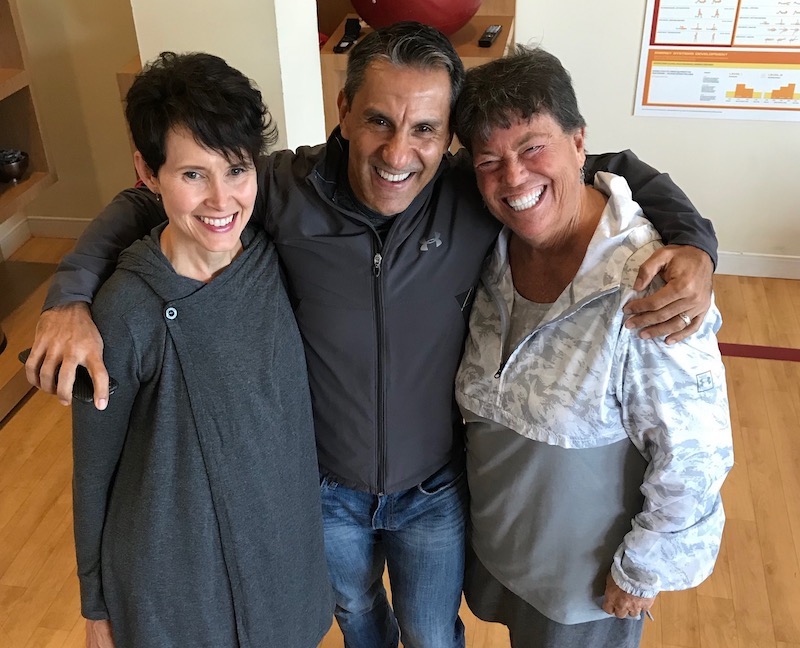Running Basics – We have about 10 people who are signed up for either the 1/2 marathon (running 13.1 miles) or the Marathon Relay (running 4-6 miles with a team of 5 people completing a marthon)
So the next few months we are trying to give all of you some great tips and pointers on jogging/running.
If you are still intersted in getting in, CLICK HERE for Information about the Dallas White Rock event we will be doing on December 5th.
The Tip of the week will help you with your form and posture with running.
Part One: Running Basics
[This is part one of the three of the series on running tips that Get You In Shape Personal Trainer Julie McCan will present over the next 3 months].
I have never liked running. Although I have gotten somewhat better at doing since I started Boot Camp, it is usually the part of the workout I least enjoy. The reason I don’t enjoy it is because it is hard for me to do and therefore, I am not very good at it either. That said, the only way I know how to overcome my dislike of doing an exercise is to get better at doing it… so running is my current challenge.
My goal is to improve my running enough so that I don’t dread doing it so much. Hopefully, I may end up even looking forward to it. But, in order to get better at running, I know I need to run more than just running during class… a lot more! I decided that having a goal to work toward would provide some motivation for me. So, encouraged by a few others in class (thank you Carla and Stacy), I registered for the White Rock Half Marathon. Yes, that is over 13 miles!
In reality, my goal has now gone beyond to simply improve the dread factor I have toward running and to actually become a decent runner. I started training the first of September and the race is December 5th, 2010 giving me about 3 months to get in the best running shape I can.
How to start? It seemed easy enough – all I needed to do was put on my shoes and go, right? Wrong!
Since I am a beginner when it comes to running, the Trainer in me wanted to do it right. To learn how get the most out of running and become the best runner I can be, I started by doing research. I have found several websites that have helped me but the one I like the best is www.running.about.com. Although I encourage all of you to use it and other resources to help you with your running, I thought I would take you through my journey – both through learning the science and technique – as well as keeping you posted on my progress toward becoming a true runner.
The first thing I had to do was reassess was my running form. Improving your running form can help you run faster, more efficiently, and with less stress on your body. Specifically, I had some concerns about my stride and my breathing. Through information like the tips below, I quickly learned how to move from being a heel runner to a mid-foot runner. I am still working on my breathing technique but using the tips below will help improve that too.
If you are a beginner like me, or just someone that wants to improve your running, going back to important basics will be very helpful.
[Disclaimer! Before you get started on any new exercise program, including running, please check with your Doctor to get medical clearance just to make it is right for you.]
Follow these tips to work on perfecting your running form.
- Look Ahead: Your eyes should be focused on the ground about 10 to 20 feet ahead of you. Don’t stare at your feet. Not only is this proper running form, but it’s also a safer way to run because you can see what’s coming.
- Land Mid-foot: Don’t be a toe runner or a heel-striker. If you land on your toes, your calves will get tight or fatigue quickly and you may develop shin pain. You will also tend to bounce which is inefficient as well. Landing on your heels means you have overstrided and you are stopping your forward momentum and causing undue stress on your knees, which wastes energy and may cause injury. Try to land on the middle of your foot, and then roll through to the front of your toes.To determine what type of footstriker you are, pay attention to which part of foot you’re landing on when you’re running. If you’re a heel-striker or toe-striker, you can try to switch to landing on your mid-sole by not overstriding. Make sure that you don’t lunge forward with your feet. Focus on landing on the balls of your feet, with your foot directly underneath your body with every step. A short, low arm swing is the key to keeping your stride short and close to the ground. You can practice changing your footstrike during shorter runs at first, and then work your way up to doing
- Keep Hands at Your Waist: Try to keep your hands at waist level, right about where they might lightly brush your hip. Your arms should be at a 90 degree angle. Some beginners have a tendency to hold their hands way up by their chest, especially as they get tired. Ironically, you may actually get more tired by holding your arms that way and you’ll start to feel tightness and tension in your shoulders and neck.
- Relax Your Hands/Upper body: As you run, keep your arms and hands as relaxed as possible. You can gently cup your hands, as if you are holding an egg and you don’t want to break it. Don’t clench your fists because it can lead to tightness in the arms, shoulders, and neck. It’s important to stay relaxed when running because tension can cause improper running form, which can lead to fatigue, decreased performance, and even injuries.
Runners typically get tense in their upper body. Throughout your run, try to check your running form to make sure you’re not allowing any tension to creep into your run. Here’s what to look for and what to do:
Check your shoulders. Are your shoulders moving up toward your ears? If so, roll your head, push your shoulder blades together, and let your shoulders drop.
Keep arms at a 90-degree angle. Are your arms at a 90-degree angle? When runners get tired or tense, their hands start to move up towards their shoulders. If you notice this happening, drop your arms and shake out your arms. Then re-position them at a 90-degree angle.
Relax your hands and wrist. Are your hands in a tight fist? If you’re clenching your fists, the tension in your hands will move from there up your arms to your shoulders and neck. Try to keep your hands and wrists relaxed. You should keep your hand in a loose fist, almost as if you’re holding an egg and you don’t want to break it.
Keep your arms at your side. Are your arms crossing over your chest? Your arms should swing at your side and not cross your chest. If you’re crossing over your chest, your arms will start moving up toward your shoulders and you’ll find yourself hunching over more (which also makes it harder to breathe). Keep your arms at your sides, parallel to each other. - Check Your Posture: Keep your posture straight and erect. Your head should be up, your back straight, and shoulders level. Check your posture once in a while. When you’re tired at the end of your run, it’s common to slump over a little, which can lead to neck, shoulder, and lower-back pain. When you feel yourself slouching, poke your chest out.
- Relax Your Shoulders: Your shoulders should be relaxed and square or facing forward, not hunched over. Rounding the shoulders too far forward tends to tighten the chest and restrict breathing.
- Rotate Arms from the Shoulder: Your arms should swing back and forth from your shoulder joint, not your elbow joint.
- Don’t Bounce: Try to keep your stride low to the ground and focus on quick stride turnover. Too much up-and-down movement is wasted energy and can be hard on your lower body. The higher you lift yourself off the ground, the greater the shock you have to absorb when landing and the faster your legs will fatigue.
- Keep Arms at Your Side: Avoid side-to-side arm swinging. If your arms cross over your chest, you’re more likely to slouch, which means you’re not breathing efficiently. Imagine a vertical line splitting your body in half — your hands should not cross it.
- Inhale through both your nose and mouth/Exhaled through your mouth: You should allow air to enter through both your mouth and nose when you’re running. Your muscles need oxygen to keep moving and your nose simply can’t deliver enough. Make sure you’re breathing more from your diaphragm, or belly, not from your chest — that’s too shallow. Deep belly breathing allows you to take in more air, which can also help prevent side stitches. You should exhale through your mouth and try to focus on exhaling fully, which will remove more carbon dioxide and also help you inhale more deeply. Here are a few more tips for breathing while running:
- Try to take three footstrikes for every inhale, and two footstrikes for every exhale.
- As a beginner, try to run at a pace at which you can breathe easily. Use the “talk test” to figure out if your pace is appropriate. You should be able to speak in full sentences, without gasping for air.
- Slow down or walk if you’re running out of breath. If you relax and slow the pace, breathing problems often take care of themselves. Don’t overthink it!
I will put this last tip into practice during my next run and I’ll keep you posted on how well it works for me. Thanks to Christine Luff, for these tips and where you can find more information in here “Guide to Running & Jogging” at www.running.about.com.
Written by Julie McCan. Julie is a Certified Personal Trainer for Get You In Shape.
www.GetYouInShape.com
If you live or work in Dallas, Uptown, Lakewood, Downtown Dallas, Highland Park, University Park, Lake Highlands, White Rock Lake, Richardson, Mesquite, Arlington, Grand Prairie and other Dallas cities, the Dallas Boot Camp is minutes away from you. If you live or work in Coppell, Valley Ranch, Irving, Lewisville, Las Colinas, Carrollton, Flower Mound, Grapevine, Addison, Corinth, Highland Village, Dallas, and Famers Branch, the Coppell Boot Camps are just minutes away from you. Get You In Shape Boot Camp.
Get You In Shape’s programs include the Get You In Shape Boot Camp (Dallas and Coppell), 24 and 40 Day Challenge, sports specific training, weight loss programs, Corporate wellness plans, nutrition plans, core fitness training, strength training, toning and more. Clients include athletes (golf, basketball, tennis, football, track, baseball, baseball, volleyball, and softball) corporate executives, professionals, weekend warriors, cheerleaders, dancers, models, stay at home moms, and anyone looking for results.
Owner Brad Linder, has been featured in numerous newspapers and even as the fitness expert on the news 8 (ABC). He continues to use the gifts that he has been given to help serve the needs others have when it come to being healthy, losing weight, sports, toning up, and overall fitness.
More information about Get You In Shape at www.getyouinshape.com



